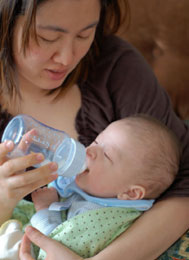The History of Adoption

Ancient adoptions were not always in the interest of the child
by Beth Rowen
 Related Links |
For many people today, adoption is a way to create a family. For others, adoption helps to expand a family. Adoptions in ancient times, however, were not conducted in the interests of children. In fact, quite the opposite is true. Orphaned or abandoned children often became slaves.
Ancient adoptions in the Roman Empire mostly involved adult males and the aristocracy. Wealthy families that were sonless would adopt older boys or men to provide them with male heirs. Several Roman emperors, including Hadrian and Marcus Aurelius, were adopted.
Adoption as practiced in ancient times declined during the Middle Ages, as bloodlines became paramount for inheritance. At this point, the Catholic Church began to encourage adoptions in the interest of abandoned and orphaned children, establishing homes and standards of treatment for these children.
Modern adoption has its roots in the United States
From the time the first settlers arrived in the United States, war, poverty, disease, and other tragedies left countless children orphaned. Until the 1850s, informal adoptions were the norm; another family, usually a relative, would take in an orphaned child. As the number of these informal adoptions increased, the need for legalizing the process became apparent. In 1851, Massachusetts passed the nation’s first adoption statute. It required that judges determine if adoptive parents had consent from the adoptee’s guardian or parent, “sufficient ability to bring up the child,” and that it was “fit and proper that such adoption should take effect.”
The number of orphans in the United States exploded amid the Civil War and as immigration increased in the 19th century. Homeless children crowded city streets, particularly in New York. Charles Loring Brace, a protestant minister who founded the Children's Aid Society of New York in 1853, conceived the idea to relocate and find homes for the orphans. Between 1859 and 1929 some 200,000 orphaned children were transported from coastal cities to rural areas in the Midwest. They traveled on what were called “Orphan Trains.” The outcome of this controversial social experiment was mixed. Some say the orphans became indentured servants; others say the children were spared a life on the streets. Nevertheless, the program ushered in America’s foster care system.
In the early 20th century, part of President Theodore Roosevelt’s Progressive Movement was aimed at improving child welfare. At the First White House Conference on the Care of Dependent Children in 1909, Roosevelt recommended moving away from institutional orphanages and toward placing children in family homes. Consequently, other states followed Massachusetts and passed legislation governing adoption, but the consent provision was loosely implemented. In 1917, Minnesota passed a law mandating that a child welfare agency investigate all placements.
Adoption gains momentum
Following World War I, the demand for babies began to grow. Three major factors that contributed to the new adoption trend included the sharp drop in population caused by the war, the influenza epidemic of 1918, and the development of a successful feeding formula. The number of adoptions exploded, and “closed” adoptions became the norm. In closed adoptions, the identities of the birth parents and adoptive parents were kept a secret because, it was thought, this helped the child bond to his or her new family and avoid the stigma of illegitimacy.
By the mid-1950s the demand for healthy infants began to exceed the number available. Factors contributing to the decline in available infants included the increased availability of effective contraception, a rise in the abortion rate following Roe v. Wade in 1973, and an increase in the number of unmarried women keeping their babies rather than giving them up for adoption.
During the 1970s, “open” adoption, in which adoptive and birth parents are known to each other, became more accepted. A growing number of prospective parents adopted through private placement, by contacting a birth mother directly, through an advertisement, through the services of a lawyer, or through other professionals specializing in adoption. Adoptions reached their highest point in 1970, and have since leveled.
Recent trend toward international adoption
Since the late 20th century, international adoption has become prevalent in the United States, providing homes to children that have been orphaned by disease, war, poverty, and in the case of China, a national policy that permits couples to have only one child. Indeed, celebrity adoptions have become commonplace and generate intense publicity—wanted or not. You can’t look at a magazine at the grocery store checkout without seeing Angelina Jolie and Brad Pitt’s growing brood plastered on the covers of tabloids. But millions of people experienced the joys of adoption long before it became a media event.
- More from Family Trends







